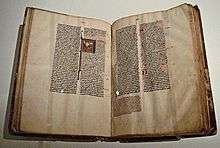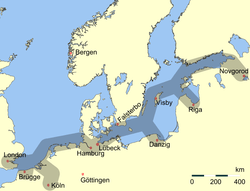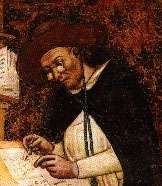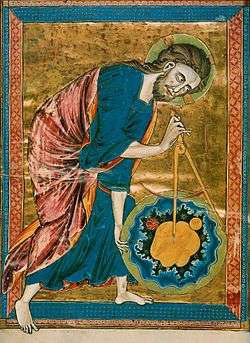Renaissance of the 12th century
The Renaissance of the 12th century was a period of many changes at the outset of the high Middle Ages. It included social, political and economic transformations, and an intellectual revitalization of Western Europe with strong philosophical and scientific roots. These changes paved the way for later achievements such as the literary and artistic movement of the Italian Renaissance in the 15th century and the scientific developments of the 17th century.[1]
Medieval renaissances
The groundwork for the rebirth of learning was laid by the process of political consolidation and centralization of the monarchies of Europe.[2] This process of centralization began with Charlemagne (768-814) King of the Franks and later (800-814), Holy Roman Emperor. Charlemagne's inclination towards education, which led to the creation of many new churches and schools where students were required to learn Latin and Greek, has been called the "Carolingian Renaissance." A second "renaissance" occurred during the reign of Otto I (The Great) (936-973) King of the Saxons[3] and from 962 onwards Emperor of the Holy Roman Empire. Otto was successful in unifying his kingdom asserting his right to appoint bishops and archbishops throughout his kingdom. Otto's assumption of this ecclesiastical power brought him into close contact with the best educated and ablest class of men in his kingdom.[4] From this close contact many new reforms were introduced in the Saxon Kingdom and in the Holy Roman Empire. Thus, Otto's reign has also been called a "renaissance." Therefore, the Renaissance of the twelfth century has been identified as the third and final of the medieval renaissances. Yet the renaissance of the twelfth century was far more thoroughgoing than those renaissances that preceded in the Carolingian or in the Ottonian periods.[5] Indeed, Charlemagne's "Carolingian Renaissance" was really more particular to Charlemagne himself, and was really more of a "veneer on a changing society"[6] than a true renaissance springing up from society. Indeed, the same might be said of the Ottonian Renaissance.
Historiography
Charles H. Haskins was the first historian to write extensively about a renaissance that ushered in the High Middle Ages starting about 1070. In 1927, he wrote that:
[The 12th century in Europe] was in many respects an age of fresh and vigorous life. The epoch of the Crusades, of the rise of towns, and of the earliest bureaucratic states of the West, it saw the culmination of Romanesque art and the beginnings of Gothic; the emergence of the vernacular literatures; the revival of the Latin classics and of Latin poetry and Roman law; the recovery of Greek science, with its Arabic additions, and of much of Greek philosophy; and the origin of the first European universities. The 12th century left its signature on higher education, on the scholastic philosophy, on European systems of law, on architecture and sculpture, on the liturgical drama, on Latin and vernacular poetry...[7]
British art historian Kenneth Clark wrote that Western Europe's first "great age of civilisation" was ready to begin around the year 1000. From 1100, he wrote, monumental abbeys and cathedrals were constructed and decorated with sculptures, hangings, mosaics and works belonging to one of the greatest epochs of art and providing stark contrast to the monotonous and cramped conditions of ordinary living during the period. Abbot Suger of the Abbey of St. Denis is considered an influential early patron of Gothic architecture and believed that love of beauty brought people closer to God: "The dull mind rises to truth through that which is material". Clark calls this "the intellectual background of all the sublime works of art of the next century and in fact has remained the basis of our belief of the value of art until today".[8]
Translation movement

The translation of texts from other cultures, especially ancient Greek works, was an important aspect of both this Twelfth-Century Renaissance and the latter Renaissance (of the 15th century), the relevant difference being that Latin scholars of this earlier period focused almost entirely on translating and studying Greek and Arabic works of natural science, philosophy and mathematics, while the later Renaissance focus was on literary and historical texts.
Trade and commerce

In Northern Europe, the Hanseatic League was founded in the 12th century, with the foundation of the city of Lübeck in 1158–1159. Many northern cities of the Holy Roman Empire became Hanseatic cities, including Hamburg, Stettin, Bremen and Rostock. Hanseatic cities outside the Holy Roman Empire were, for instance, Bruges, London and the Polish city of Danzig (Gdańsk). In Bergen and Novgorod the league had factories and middlemen. In this period the Germans started colonizing Eastern Europe beyond the Empire, into Prussia and Silesia.
In the late 13th century, a Venetian explorer named Marco Polo became one of the first Europeans to travel the Silk Road to China. Westerners became more aware of the Far East when Polo documented his travels in Il Milione. Even though Marco Polo was an Italian, his works were available in French.[9] Marco Polo was followed by numerous Christian missionaries to the East, such as William of Rubruck, Giovanni da Pian del Carpini, Andrew of Longjumeau, Odoric of Pordenone, Giovanni de Marignolli, Giovanni di Monte Corvino, and other travelers such as Niccolò da Conti.
Science
After the collapse of the Western Roman Empire, Western Europe had entered the Middle Ages with great difficulties. Apart from depopulation and other factors, most classical scientific treatises of classical antiquity, written in Greek, had become unavailable. Philosophical and scientific teaching of the Early Middle Ages was based upon the few Latin translations and commentaries on ancient Greek scientific and philosophical texts that remained in the Latin West, not to mention that even that remained at minimal levels.
This scenario changed during the renaissance of the 12th century. The increased contact with the Islamic world in Muslim-dominated Spain and Sicily, the Crusades, the Reconquista, as well as increased contact with Byzantium, allowed Europeans to seek and translate the works of Hellenic and Islamic philosophers and scientists, especially the works of Aristotle. Several translations were made of Euclid but no true commentary was written until the middle of the 13th century.[11]
The development of medieval universities allowed them to aid materially in the translation and propagation of these texts and started a new infrastructure which was needed for scientific communities. In fact, the European university put many of these texts at the center of its curriculum,[12] with the result that the "medieval university laid far greater emphasis on science than does its modern counterpart and descendent."[13]
At the beginning of the 13th century there were reasonably accurate Latin translations of the main ancient Greek scientific works. From then on, these texts were studied and elaborated, leading to new insights into the phenomena of the universe. The influence of this revival is evident in the scientific work of Robert Grosseteste.[14]
Technology

During the High Middle Ages in Europe, there was increased innovation in means of production, leading to economic growth.
Alfred Crosby described some of this technological revolution in The Measure of Reality : Quantification in Western Europe, 1250-1600 and other major historians of technology have also noted it.
- The earliest written record of a windmill is from Yorkshire, England, dated 1185.
- Paper manufacture began in Spain around 1100, and from there it spread to France and Italy during the 12th century.
- The magnetic compass aided navigation, attested in Europe in the late 12th century.
- The astrolabe returned to Europe via Islamic Spain.
- The West's oldest known depiction of a stern-mounted rudder can be found on church carvings dating to around 1180.
Latin literature
The early 12th century saw a revival of the study of Latin classics, prose, and verse before and independent of the revival of Greek philosophy in Latin translation. The Cathedral schools at Chartres, Orleans, and Canterbury were centers of Latin literature staffed by notable scholars. John of Salisbury, secretary at Canterbury, became the bishop of Chartres. He held Cicero in the highest regard in philosophy, language, and the humanities. Latin humanists possessed and read virtually all the Latin authors we have today—Ovid, Virgil, Terence, Horace, Seneca, Cicero. The exceptions were few—Tacitus, Livy, Lucretius. In poetry, Virgil was universally admired, followed by Ovid.[15]
Like the earlier Carolingian revival, the 12th-century Latin revival would not be permanent. While religious opposition to pagan Roman literature existed, Haskins argues that “it was not religion but logic” in particular “Aristotle’s New Logic toward the middle of [the 12th] century [that] threw a heavy weight on the side of dialectic ...” at the expense of the letters, literature, oratory, and poetry of the Latin authors. The nascent universities would become Aristotelean centers displacing the Latin humanist heritage[16] until its final revival by Petrarch in the 14th century.
Roman law
The study of the Digest was the first step to the revival of Roman legal jurisprudence and the establishment of Roman law as the basis of civil law in continental Europe. The Bologna University was Europe's center of legal scholarship during this period.
Scholasticism
A new method of learning called scholasticism developed in the late 12th century from the rediscovery of the works of Aristotle; the works of medieval Muslims and Jews influenced by him, notably Maimonides, Avicenna (see Avicennism) and Averroes (see Averroism). The great scholastic scholars of the 13th century were Albertus Magnus, Bonaventure and Thomas Aquinas. Those who practiced the scholastic method defended Roman Catholic doctrines through secular study and logic. Other notable scholastics ("schoolmen") included Roscelin and Peter Lombard. One of the main questions during this time was the problem of the universals. Prominent non-scholastics of the time included Anselm of Canterbury, Peter Damian, Bernard of Clairvaux, and the Victorines.[17]
Arts
The 12th century renaissance saw a revival of interest in poetry. Writing mostly in Latin, contemporary poets produced significantly more work than those of the Carolingian Renaissance. The subject matter varied wildly across epic, lyric, and dramatic. Meter was no longer confined to the classical forms and began to diverge into newer schemes. Additionally, the division between religious and secular poetry became smaller.[18] In particular, the Goliards were noted for profane parodies of religious texts.[19]
These expansions of poetic form contributed to the rise of vernacular literature, which tended to prefer the newer rhythms and structures.[20]
See also
- Continuity thesis
- Crisis of the Late Middle Ages
- Gothicmed
- Jacques Le Goff, French historian
Notes
- ↑ (Bauer 2013, p. 1 - preface)
- ↑ (Hoyt 1976, p. 329)
- ↑ (Hoyt 1976, p. 197)
- ↑ (Hoyt 1976, p. 198)
- ↑ (Hoyt 1976, p. 366)
- ↑ (Hoyt 1976, p. 164)
- ↑ (Haskins 1927, p. viii - introduction)
- ↑ Civilisation (TV series)
- ↑ (Hoyt 1976, p. 410)
- ↑ The compass in this 13th-century manuscript is a symbol of God's act of Creation.
* Thomas Woods, How the Catholic Church Built Western Civilization, (Washington, DC: Regenery, 2005), ISBN 0-89526-038-7 - ↑ Robert Robert Louis Benson, Giles Constable, Carol Carol Dana Lanham, eds. (1991). Renaissance and Renewal in the Twelfth Century. Harvard University Press. p. 471.
- ↑ Toby Huff, Rise of early modern science 2nd ed. p. 180-181
- ↑ Edward Grant, "Science in the Medieval University", in James M. Kittleson and Pamela J. Transue, ed., Rebirth, Reform and Resilience: Universities in Transition, 1300-1700, Columbus: Ohio State University Press, 1984, p. 68
- ↑ Jane E. House (Spring 2013). "Learning How Much Twelfth Century Scientists knew and How They Knew It". Folio. Graduate Center of the City University of New York: 2.
- ↑ Charles Homer Haskins. The Renaissance of the Twelfth Century. Cambridge: Harvard University Press, 1927. Chapter I-IV
- ↑ (Haskins 1927, pp. 98–99)
- ↑ Gilson, Etienne (1991). The Spirit of Medieval Philosophy (Gifford Lectures 1933-35). Notre Dame, IN: University of Notre Dame Press. p. 490. ISBN 978-0-268-01740-8.
- ↑ (Haskins 1927, pp. 153–158)
- ↑ (Haskins 1927, pp. 183–185)
- ↑ (Haskins 1927, p. 190)
Bibliography
- Bauer, Susan Wise (2013), The History of the Renaissance World: From the Rediscovery of Aristotle to the Conquest of Constantinople, New York: W. W. Norton & Company, ISBN 978-0-3930-5976-2
- Benson, Robert L., Giles Constable, and Carol D. Lanham, eds. (1982). Renaissance and Renewal in the Twelfth Century. Cambridge: Harvard University Press.
- Haskins, Charles Homer (1927), The Renaissance of the Twelfth Century, Cambridge: Harvard University Press, ISBN 978-0-6747-6075-2
- Hoyt, Robert S.; Chodorow, Stanley (1976), Europe in the Middle Ages (3 ed.), New York: Harcourt, Brace Jovanovich, Inc., ISBN 978-0-1552-4712-3
External links
- A brief analysis of Haskins, Renaissance of the Twelfth Century
- A bibliography of the twelfth-century renaissance

